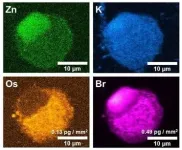(Press-News.org) Engineers at the University of California San Diego have created a four-legged soft robot that doesn't need any electronics to work. The robot only needs a constant source of pressurized air for all its functions, including its controls and locomotion systems.
The team, led by Michael T. Tolley, a professor of mechanical engineering at the Jacobs School of Engineering at UC San Diego, details its findings in the Feb. 17, 2021 issue of the journal Science Robotics.
"This work represents a fundamental yet significant step towards fully-autonomous, electronics-free walking robots," said Dylan Drotman, a Ph.D. student in Tolley's research group and the paper's first author.
Applications include low-cost robotics for entertainment, such as toys, and robots that can operate in environments where electronics cannot function, such as MRI machines or mine shafts. Soft robots are of particular interest because they easily adapt to their environment and operate safely near humans.
Most soft robots are powered by pressurized air and are controlled by electronic circuits. But this approach requires complex components like circuit boards, valves and pumps--often outside the robot's body. These components, which constitute the robot's brains and nervous system, are typically bulky and expensive. By contrast, the UC San Diego robot is controlled by a light-weight, low-cost system of pneumatic circuits, made up of tubes and soft valves, onboard the robot itself. The robot can walk on command or in response to signals it senses from the environment.
"With our approach, you could make a very complex robotic brain," said Tolley, the study's senior author. "Our focus here was to make the simplest air-powered nervous system needed to control walking."
The robot's computational power roughly mimics mammalian reflexes that are driven by a neural response from the spine rather than the brain. The team was inspired by neural circuits found in animals, called central pattern generators, made of very simple elements that can generate rhythmic patterns to control motions like walking and running.
To mimic the generator's functions, engineers built a system of valves that act as oscillators, controlling the order in which pressurized air enters air-powered muscles in the robot's four limbs. Researchers built an innovative component that coordinates the robot's gait by delaying the injection of air into the robot's legs. The robot's gait was inspired by sideneck turtles.
The robot is also equipped with simple mechanical sensors--little soft bubbles filled with fluid placed at the end of booms protruding from the robot's body. When the bubbles are depressed, the fluid flips a valve in the robot that causes it to reverse direction.
The Science Robotics paper builds on previous work by other research groups that developed oscillators and sensors based on pneumatic valves, and adds the components necessary to achieve high-level functions like walking.
How it works
The robot is equipped with three valves acting as inverters that cause a high pressure state to spread around the air-powered circuit, with a delay at each inverter.
Each of the robot's four legs has three degrees of freedom powered by three muscles. The legs are angled downward at 45 degrees and composed of three parallel, connected pneumatic cylindrical chambers with bellows. When a chamber is pressurized, the limb bends in the opposite direction. As a result, the three chambers of each limb provide multi-axis bending required for walking. Researchers paired chambers from each leg diagonally across from one another, simplifying the control problem.
A soft valve switches the direction of rotation of the limbs between counterclockwise and clockwise. That valve acts as what's known as a latching double pole, double throw switch--a switch with two inputs and four outputs, so each input has two corresponding outputs it's connected to. That mechanism is a little like taking two nerves and swapping their connections in the brain.
Next steps
In the future, researchers want to improve the robot's gait so it can walk on natural terrains and uneven surfaces. This would allow the robot to navigate over a variety of obstacles. This would require a more sophisticated network of sensors and as a result a more complex pneumatic system.
The team will also look at how the technology could be used to create robots, which are in part controlled by pneumatic circuits for some functions, such as walking, while traditional electronic circuits handle higher functions.
INFORMATION:
This work is supported by the Office of Naval Research, grant numbers N00014-17-1-2062 and N00014-18-1-2277.
Electronics-free pneumatic circuits for controlling soft legged robots
Dylan Drotman, Saurabh Jadhav, David Sharp, Christian Chan and Michael T. Tolley, Department of Mechanical and Aerospace Engineering and Contextual Robotics Institute, UC San Diego
The unprecedented and deadly blazes that engulfed the American West in 2020 attest to the increasing number, size and severity of wildfires in the region. And while scientists predict the climate crisis will exacerbate this situation, there's still much discussion around its contributing factors.
With this in mind, scientists at five western universities, including UC Santa Barbara, investigated the effects of human-driven climate change and more than a century of fire suppression, which has produced dense forests primed to burn. Their research, published in the journal Environmental ...
In the search for planets capable of sustaining life, an international research team with members from ETH has taken a significant step forward. As the researchers reported recently in the journal Nature Communications, they found signs of a Neptune-sized planet in the Alpha Centauri star system, a mere 4.4 light years away from Earth. This exoplanet is located in a zone that may offer suitable conditions for life. The team was able to collect data with unprecedented sensitivity, thus registering even very weak signals.
Earth is a disruptive factor
Thanks to the new process, the researchers have advanced one step closer to ...
In the paper, 'Tracking Reactions of Asymmetric Organo-Osmium Transfer Hydrogenation Catalysts in Cancer Cells', published in the journal Angewandte Chemie, researchers from the University of Warwick have, for the first time, used the new 185 m beamline to track Osmium in a single cancer cell at a scale of 100 nanometers.
They used two techniques to track potential treatments in cancer cells, the first, ICP-MS, which stands for Inductively Coupled Plasma-Mass Spectrometry, can quantify a wide range of natural and drug elements in millions of cells. However, to investigate a single cancer cell, researchers used synchrotron X-ray Fluorescence ...
Gravity might play a bigger role in the formation of elementary particles than scientists used to believe. A team of physicists from RUDN University obtained some solutions of semi-classical models that describe particle-like waves. They also calculated the ratio between the gravitational interaction of particles and the interaction of their charges. The results of the study were published in the Universe journal.
Due to their small size, the gravitational interaction between elementary particles (electrons, protons, and neutrons) is weak compared to Coulomb forces--attraction ...
Experts say English slang and regional dialect should not be banned from classrooms but when you're getting to grips with a second language how helpful is it to learn non-standard lingo?
Very, says Sascha Stollhans, of the Department of Languages and Cultures at Lancaster University, who argues that standardised language norms are artificial and language learners should learn about all aspects of language, even the controversial ones.
In his policy paper, just published in the Languages, Society & Policy Journal, he says:
There are concerns among professionals that introducing learners to 'non-standard' language could lead to ambiguity and confusion and that students might be penalised for using it in assessments.
Linguistic variation is a rich area of study that can appeal to language ...
Researchers from the University of Granada warn that an accumulation of fatty tissue in the neck (both the double chin and the deeper deposits, located between muscles and around the cervical vertebrae) is a predictor of central and overall adiposity, cardiometabolic risk, and a pro-inflammatory profile in sedentary young adults.
A study conducted by researchers from the University of Granada (UGR) has revealed that an accumulation of fatty tissue in the neck is a predictor of central and overall adiposity, cardiometabolic risk (heart problems), and a pro-inflammatory profile in sedentary young adults.
Traditionally, the accumulation of visceral adipose tissue has been considered one of the factors most strongly ...
Research teams from Ruhr-Universität Bochum (RUB) and the University of Copenhagen have therefore developed an approach that can predict the optimal composition and confirm its accuracy with high-throughput experiments. They report in the journal Angewandte Chemie International Edition of 28. December 2020.
Much less expensive elements than previous catalysts
Many electrochemical reactions go through several steps. Each should be optimized on a catalyst surface if possible, but different requirements apply to each step. "Since previous catalysts usually had only one optimized ...
Blockchain is a decentralized technology used to protect the security and privacy of online transactions and is usually associated with cryptocurrencies such as Bitcoin. However, it is a mechanism that can be applied to all kinds of digital exchanges. In a new study, researchers from the K-riptography and Information Security for Open Networks (KISON) group at the Internet Interdisciplinary Institute (IN3) Amna Qureshi and professor David Megías (who is also the director of the IN3) analysed existing blockchain-based multimedia content protection systems and established a taxonomy to classify them according ...
Research has found fidaxomicin, an antibiotic usually used to treat bowel infections, prevents growth of resistant strains of Mycobacterium tuberculosis (MTb) in the lab.
Published in the Journal of Medical Microbiology, the research found that fidaxomicin was more effective than existing tuberculosis (TB) medication at preventing growth of the bacterium that causes TB.
Researchers compared the activity of fidaxomicin and rifampicin, an antibiotic currently used to treat TB, against 72 different strains of MTb. Of these strains, 34 were resistant to multiple antibiotics. They found that fidaxomicin could prevent growth of all 72 strains at lower doses than rifampicin.
Both of the drugs tested work in a similar way and ...
Ground-breaking research led by University of Limerick has revealed for the first time that the immune system directly links personality to long-term risk of death.
The study sheds new light on why people who are more conscientious tend to live longer.
Results from the new international study published in the journal Brain, Behavior, and Immunity have found that the immune system plays a previously unknown role in the link between personality traits and long-term risk of death.
"Personality is known to be associated with long-term risk of death, it is a well replicated ...



